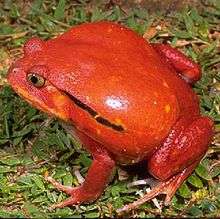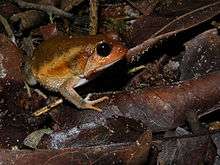Tomato frog
Tomato frogs are any of the three species of genus Dyscophus (family Microhylidae): D. antongilii, D. insularis, or D. guineti.[1] Dyscophus is the only genus in subfamily Dyscophinae. They are endemic to Madagascar[2]. The three Dyscophus species differ in chromatin pattern. Both sexes of D. guineti show a heteromorphic chromosome pair 11, with one element larger (11a) than the other 11b due to the presence of the large terminal tract on the short arm with an euchromatic band enclosed between two heterochromatic bands. This condition in dyscophus probably characterizes the beginning of a cladogenetic process. [3]
| Tomato frog | |
|---|---|
 | |
| Tomato frog, Dyscophus antongilii | |
| Scientific classification | |
| Kingdom: | Animalia |
| Phylum: | Chordata |
| Class: | Amphibia |
| Order: | Anura |
| Family: | Microhylidae |
| Subfamily: | Dyscophinae Boulenger, 1882 |
| Genus: | Dyscophus Grandidier, 1872 |
| Diversity | |
| 3 species | |
The common name comes from D. antongilii's bright red color. When threatened, a tomato frog puffs up its body. When a predator grabs a tomato frog in its mouth, the frog's skin secretes a thick substance that numbs up the predator's eyes and mouth, causing the predator to release the frog to free up its eyes. The gummy substance contains a toxin that occasionally causes allergic reactions in humans. The allergic reaction will not kill a human and the frog secretes it only when frightened.
The lifespan of the tomato frog can be from 6 to 8 years. When adult, the colors may vary from yellowish orange to deep red. Tomato frogs will reach sexual maturity in 9–14 months. Females are larger than males and can reach 4 inches in length. Males can reach 2 to 3 inches in length. Most females range from reddish-orange bright dark red. The bellies are usually more yellowish, and sometimes there are black spots on the throat. But males are not as brightly colored but more of a duller orange or brownish-orange. Juveniles are also dull in color and develop brighter coloration as they mature. They are also on the endangered species list. They breed in the rainy season and are nocturnal. They tend to eat small insects and invertebrates.
Species
There are three different species:[1]
| Image | Binomial name and author | Common name | Distribution | |
|---|---|---|---|---|
 | Dyscophus antongilii Grandidier, 1877 | Tomato frog | Madagascar | |
 | Dyscophus guineti (Grandidier, 1875) | Sambava tomato frog | Madagascar | |
 | Dyscophus insularis Grandidier, 1872 | Antsouhy tomato frog | Madagascar | |
Reproductive activity
Tomato frogs lay fresh eggs during every month of the year except for November. Their reproductive activity is high during the months January–May and low between the months June–December.[4]
References
- Frost, Darrel R. (2014). "Dyscophus Grandidier, 1872". Amphibian Species of the World: an Online Reference. Version 6.0. American Museum of Natural History. Retrieved 21 August 2014.
- Frost, Darrel R. (2014). "Dyscophinae Boulenger, 1882". Amphibian Species of the World: an Online Reference. Version 6.0. American Museum of Natural History. Retrieved 21 August 2014.
- Mezzasalma, Andreone, Aprea, Glaw, Odierna, Guarino, Marcello, Franco, Gennaro, Frank, Gaetano, Maria (2017). "When can chromosomes drive speciation? The peculiar case of the Malagasy tomato frogs (genus Dyscophus)". Web of Science. 268: 41–46.CS1 maint: multiple names: authors list (link)
- Segev, Ori; Andreone, Franco; Pala, Roberta; Tessa, Giulia; Miguel, Vences (2012-11-14). "Reproductive phenology of the tomato frog, Dyscophus antongili, in an urban pond of Madagascar's east coast". Acta Herpetologica: 331. Retrieved 13 April 2019.